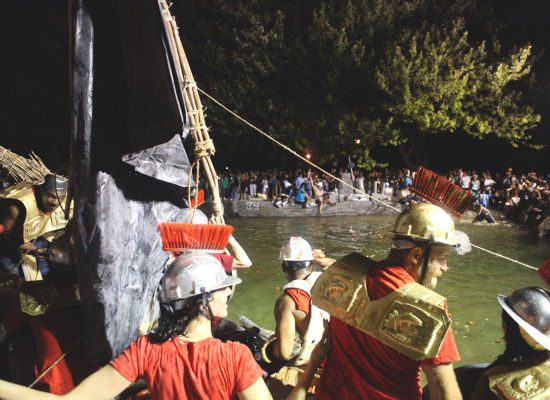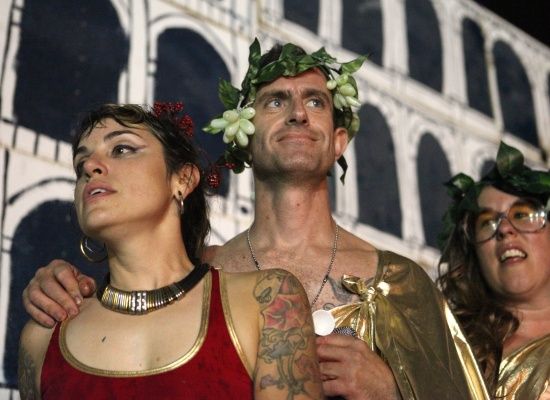The Art Aquatic with Duke Riley
Duke Riley
Those Who Are About to Die Salute You
Naumachia - Live Roman Naval Battle
Queens Museum of Art: Launch Pad Artist-in-Residence Program
Thursday, August 13th, 6 - 9:30 pm


From the Queens Museum press release:






And so, in parting: We who are about to end this article salute you, Duke. You really earned your laurels on this one.

Video from the performance:
Those Who Are About to Die Salute You
Naumachia - Live Roman Naval Battle
Queens Museum of Art: Launch Pad Artist-in-Residence Program
Thursday, August 13th, 6 - 9:30 pm
This event promised to adhere to historical precedents from the Roman Empire, at least as filtered through the popular imagination of Hollywood films like Ben Hur: bread and circuses; pomp and revelry; the heady Coliseum drama of thumbs up and thumbs down; the thrill of victory, the agony of defeat; reenacted maritime battles staged in a shallow reflecting pool; "death" by baguette or balloon sword, catapulted watermelon bomb and tomato projectile; an orgy of flotsam and jetsam; an outdoor food fight seasoned with the anarchic spirit of a college toga party. And the added promise that all of this estival mayhem was being done in the name of art.


From the Queens Museum press release:
“Those who are about to die salute you”, from the Latin “Moritori te selutant”, attributed to prisoners addressing Emperor Claudius prior to the Naumachia to which they had been fated. –52 AD
In times of economic difficulty, Roman emperors would host violent spectator sports to placate the masses. The bloodiest and most decadent of these was the NAUMACHIA - prisoners were forced to engage in full-on naval warfare within a flooded Roman amphitheater. Variations were re-popularized in empires throughout European history, always coinciding with instances of over-indulgence at the brink of financial and societal collapse.

On August 13th Duke Riley will recreate his own version of Naumachia by flooding one of the former World’s Fair fountains in Flushing Meadows Corona Park. Art dignitaries representing the Queens Museum of Art, the Brooklyn Museum, the Bronx Museum of the Arts and El Museo del Barrio will man the ships armed with baguette swords and watermelon cannon balls. Spectators wearing togas will engage with the performers during the battle, creating an atmosphere similar to the Coliseum.

Crafted from hand-collected Phragmite reeds (an invasive plant found in the Queens region) and materials recovered from the abandoned World’s Fair Ice Skating Rink and trash from the park the battling vessels will reflect naval styles from various cultures and eras, tying together the theme that political diversion has existed in all times and cultures.
A mandatory toga dress code will be strictly enforced.

Somehow I missed the event itself. Getting to Flushing Meadows Park proved too daunting a task last Thursday (the 7 train all the way out to Shea Stadium, then a 15 minute trek on foot), especially as I had a concurrent 40th anniversary Woodstock book signing and photo exhibit to attend on the terra firma of Morrison Hotel on the Bowery.
But coverage in various media outlets, both from the art press and for more general consumption, made me feel like I was actually there to experience the mass insanity.
But coverage in various media outlets, both from the art press and for more general consumption, made me feel like I was actually there to experience the mass insanity.
I am a big fan of Duke Riley's work, of his previous waterborne performances and gallery exhibitions, all marked by his unique low-tech, DIY "squirrelly genius". His plywood and fiberglass mockup of the Revolutionary War submarine Turtle challenging the Queen Mary II to battle in New York Harbor was memorable for its direct historical reference and derring-do, as was an earlier show at Magnan Gallery based on an apocryphal history of piracy which he "documented" on a small island at the northern mouth of the East River.
Riley is an original, in much the same mold as Swoon and Bruce High Quality Foundation, imbued with a warped sense of spectacle and an anarchic doggedness. He is not only able to paddle himself out to remote spots in NYC's aquatic littoral, he then produces funky, unforgettable artwork using materials and references from these arcane locations.
He is one of those can-do types, maximal rather than minimal, with a low key workingman's demeanor, an adventurous action figure who has been known to insouciantly quaff a Bud Tall Boy while the Coast Guard rushes in to terminate one or another of his art stunts. Given to material pathos, recycled materials, waterfront squats and warehouses, and a spirit of showmanship that would give P.T. Barnum pause, Riley inhabits a doubt free zone wherein no material is too moldy or ragged, no gesture too corny or hackneyed, and no craft or folk art too modest or marginal that it cannot be whipped into shape to service his will to total expression, his gesamtkunstwerk. One of his early gallery exhibitions incorporated media as diverse as video, woodblock prints, drawing, mosaic, sculpture, diorama, objects mounted in vitrines, fabric art, even scrimshaw. Riley is a great believer in layering the "authenticity", in incorporating a broad swath of objects into each of his projects to imbue them with denser synergies of meaning, resonance and cross reference.
Riley is an original, in much the same mold as Swoon and Bruce High Quality Foundation, imbued with a warped sense of spectacle and an anarchic doggedness. He is not only able to paddle himself out to remote spots in NYC's aquatic littoral, he then produces funky, unforgettable artwork using materials and references from these arcane locations.
He is one of those can-do types, maximal rather than minimal, with a low key workingman's demeanor, an adventurous action figure who has been known to insouciantly quaff a Bud Tall Boy while the Coast Guard rushes in to terminate one or another of his art stunts. Given to material pathos, recycled materials, waterfront squats and warehouses, and a spirit of showmanship that would give P.T. Barnum pause, Riley inhabits a doubt free zone wherein no material is too moldy or ragged, no gesture too corny or hackneyed, and no craft or folk art too modest or marginal that it cannot be whipped into shape to service his will to total expression, his gesamtkunstwerk. One of his early gallery exhibitions incorporated media as diverse as video, woodblock prints, drawing, mosaic, sculpture, diorama, objects mounted in vitrines, fabric art, even scrimshaw. Riley is a great believer in layering the "authenticity", in incorporating a broad swath of objects into each of his projects to imbue them with denser synergies of meaning, resonance and cross reference.


I can only imagine the wild toga party, the parade of ostentatious anachronisms and frat boy excesses, the not-ready-for-prime-time performances that Riley engineered in the shallow pond in front of the Unisphere in Flushing Meadows Corona Park, a great backdrop he handpicked for the faux Romanisms, food fights, conflagrations and all manner of sword-and-sandal playacting.
Saltz does a good job chronicling the event in his New York Magazine piece. Unfortunately he then lapses into a habitual sermonizing, falling into his self appointed role as champion of the downtrodden. If it's not the percentage of women at MoMA, it's the familiar refrain of "exactly what the art world needs right now ... a perfect example of an artist taking matters into his own hands".
Yes, Riley is a "wild card" who came up with a spectacularly messy and inclusive performance piece. But he has always worked close to the bone, with low overhead, scavenged materials, hands-on ingenuity and volunteer labor, even when the art world was still fat with patronage. To cite him as a poster boy for post-recession art is to fully misunderstand the economies of scale that govern his aesthetic choices, which are self imposed and not occasioned by the new austerity. While the recession seemingly could not come soon enough for Saltz, allowing him the opportunity to moralize and posture, this should not confuse us regarding Riley, who is at heart an original freebooter, walking the line between bricolage and piracy. It is not that uncommon an artistic posture: Rauschenberg's combines and performances from the 60s also come to mind, as does the impetus for Arte Povera.
Saltz does a good job chronicling the event in his New York Magazine piece. Unfortunately he then lapses into a habitual sermonizing, falling into his self appointed role as champion of the downtrodden. If it's not the percentage of women at MoMA, it's the familiar refrain of "exactly what the art world needs right now ... a perfect example of an artist taking matters into his own hands".
Yes, Riley is a "wild card" who came up with a spectacularly messy and inclusive performance piece. But he has always worked close to the bone, with low overhead, scavenged materials, hands-on ingenuity and volunteer labor, even when the art world was still fat with patronage. To cite him as a poster boy for post-recession art is to fully misunderstand the economies of scale that govern his aesthetic choices, which are self imposed and not occasioned by the new austerity. While the recession seemingly could not come soon enough for Saltz, allowing him the opportunity to moralize and posture, this should not confuse us regarding Riley, who is at heart an original freebooter, walking the line between bricolage and piracy. It is not that uncommon an artistic posture: Rauschenberg's combines and performances from the 60s also come to mind, as does the impetus for Arte Povera.

There is a cautionary note in Riley's Naumachia that can easily be overlooked, submerged in the roiling water and pummeled into submission by the microwaved tomatoes. Certainly comparisons between the decline of the Roman Empire and the current collapse of American hegemony are by now a given. The historical parallels between late capitalist globalization and the problems of ancient Rome have been made before, and at this point are more than a bit facile. Still, Riley would have us believe that he is resurrecting the Naumachia precisely for our contemporary moment of joblessness, deficit spending and economic panic, with the implicit critique that those who do not learn from history are doomed to repeat it. It is this sense of dour, fatalistic introspection, rather than Saltz's construct of an artist who takes the moribund art world by the horns and gives it a hearty shake, that allows us to view Riley's performance through the lens of the recession: bread and circuses fully appropriate to our age of anxiety and uncertainty.
That said, Tom Finkelpearl, director of the Queens Museum, is to be congratulated for lending the institutional support, funding and studio space to accomplish this landmark bacchanalian performance. Elements from the Naumachia will be included in Riley's solo show at the museum, scheduled to open in October 2009.
A list of rules and guidelines was distributed to the performers.

For those (like me) who weren't there, there is a Flicker page and also a page on Huffington Post full of great images.
That said, Tom Finkelpearl, director of the Queens Museum, is to be congratulated for lending the institutional support, funding and studio space to accomplish this landmark bacchanalian performance. Elements from the Naumachia will be included in Riley's solo show at the museum, scheduled to open in October 2009.
A list of rules and guidelines was distributed to the performers.

For those (like me) who weren't there, there is a Flicker page and also a page on Huffington Post full of great images.
And so, in parting: We who are about to end this article salute you, Duke. You really earned your laurels on this one.

Video from the performance:

0 Comments:
Post a Comment
<< Home